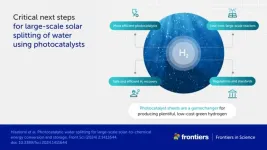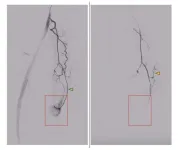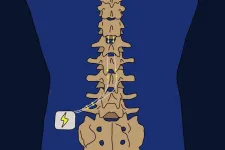(Press-News.org) In the future, we could fuel the world with sunlight and water – using sunlight to derive hydrogen fuel from H2O. Currently, most hydrogen that’s used as feedstock and fuel is derived from natural gas, and therefore doesn’t help us cut out fossil fuels. But Japanese scientists are leading the way towards a future powered by hydrogen, with new, easily-manufactured photocatalytic sheets and a proof-of-concept panel reactor which shows that it is possible to refine hydrogen fuel from water at scale.
“Sunlight-driven water splitting using photocatalysts is an ideal technology for solar-to-chemical energy conversion and storage, and recent developments in photocatalytic materials and systems raise hopes for its realization,” said Prof Kazunari Domen of Shinshu University, senior author of the article in Frontiers in Science. “However, many challenges remain.”
Steam power for the 21st century
To use sunlight to split water into oxygen and hydrogen, we need photocatalysts. Under light, these catalysts promote chemical reactions which split the water. In one-step excitation systems, the photocatalyst breaks water down to hydrogen and oxygen. These systems are simple but inefficient, with a very low solar-to-hydrogen energy conversion rate. More efficient at present are two-step excitation systems, where one photocatalyst evolves hydrogen from water and the other evolves oxygen from water.
“Obviously, solar energy conversion technology cannot operate at night or in bad weather,” said Dr Takashi Hisatomi of Shinshu University, first author of the study. “But by storing the energy of sunlight as the chemical energy of fuel materials, it is possible to use the energy anytime and anywhere.”
These systems have a higher solar-to-hydrogen energy conversion rate – but they’re not yet ready for use. We need to identify the most effective and sustainable photocatalysts, which must be robust enough to tolerate daily start-up and shut-down operations as the sun rises and sets. We also need to increase the efficiency of the conversion as much as possible, to minimize the amount of physical space needed for a reactor and make the reactor cost-effective to run - right now, using natural gas to refine hydrogen fuel is still cheaper.
An additional problem is that many methods of splitting oxygen and hydrogen produce oxyhydrogen, which is highly explosive. This risk can be eliminated by producing oxygen and the hydrogen separately, or managed by using design criteria identified by Domen and Hisatomi’s team. By experimenting with oxyhydrogen, they determined that if the gas is ignited in a small, narrow compartment, it does not explode. Materials are also important: soft PVC plastic does not explode destructively if oxyhydrogen ignites.
The future of fuel
Domen and Hisatomi’s team have already produced a successful proof of concept, running a 100m2 reactor for three years. This reactor even performed better faced with real-world sunlight than it did in under laboratory conditions.
“In our system, using an ultraviolet-responsive photocatalyst, the solar energy conversion efficiency was about one and a half times higher under natural sunlight,” said Hisatomi. “Simulated standard sunlight uses a spectrum from a slightly high latitude region. In an area where natural sunlight has more short-wavelength components than simulated reference sunlight, the solar energy conversion efficiency could be higher. However, currently the efficiency under simulated standard sunlight is 1% at best, and it will not reach 5% efficiency under natural sunlight.”
To move the technology forward and break that 5% barrier, the team says that more researchers need to develop more efficient photocatalysts and build larger experimental reactors. More real-world experiments are needed to develop the technology to the point where hydrogen is a feasible fuel option.
As part of this, the team emphasize the need to institute safety regulations and efficiency standards. An accreditation body and licensing would help to ensure the safe development of the technology, while standardized methods for determining efficiency will help identify the most effective systems.
“The most important aspect to develop is the efficiency of solar-to-chemical energy conversion by photocatalysts,” explained Domen. “If it is improved to a practical level, many researchers will work seriously on the development of mass production technology and gas separation processes, as well as large-scale plant construction. This will also change the way many people, including policymakers, think about solar energy conversion, and accelerate the development of infrastructure, laws, and regulations related to solar fuels.”
END
Experts reveal how revolutionary technological advances could use the sun to source hydrogen fuel
Crucial advances in technology could allow us to harness the power of the sun to split water into hydrogen and oxygen and siphon off renewable fuel
2024-12-03
ELSE PRESS RELEASES FROM THIS DATE:
Muscle loss could increase dementia risk
2024-12-03
CHICAGO – Skeletal muscle loss is a risk factor for developing dementia, according to a study being presented today at the annual meeting of the Radiological Society of North America (RSNA).
Skeletal muscles make up about one-third of a person’s total body mass. They are connected to the bones and allow for a wide range of movements. As people grow older, they begin to lose skeletal muscle mass.
Because age-related skeletal muscle loss is often seen in older adults with Alzheimer’s disease (AD) dementia, this study aimed to examine whether temporalis muscle ...
Minimally invasive procedure relieves knee arthritis
2024-12-03
CHICAGO – A minimally invasive procedure provides significant relief from knee pain and may prevent the need for knee replacement surgery in people with osteoarthritis, according to a study being presented this week at the annual meeting of the Radiological Society of North America (RSNA).
“This study addresses osteoarthritis, which is a significant public health issue and the leading cause of chronic pain and disability worldwide,” said the study’s lead author, Florian Nima Fleckenstein, M.D., interventional radiologist at Charité – University Hospital Berlin in Germany. “With millions of people affected by knee ...
Scientists question the use of “tipping point” metaphor in climate change discussions
2024-12-03
A group of scientists, including researchers from Rutgers University-New Brunswick, Princeton University and Carleton University, has questioned the accuracy and utility of the metaphor “tipping point” in calling attention to the threat of climate change.
The phrase, while perhaps initially useful as a clarion call that warns about sudden, drastic changes, may now be confusing the public and impeding action, researchers said.
Writing a perspective in Nature Climate Change, the scientists, from the Rutgers Climate and Energy Institute, Princeton’s Center ...
Ecosystems: New study questions common assumption about biodiversity
2024-12-03
Plant species can fulfil different functions within an ecosystem, even if they are closely related to each other. This surprising conclusion was reached by a global analysis of around 1.7 million datasets on plant communities. The study was led by Martin Luther University Halle-Wittenberg (MLU) and the University of Bologna. Their findings overturn previous assumptions in ecology. The study was published in "Nature Ecology & Evolution" and offers insights for nature conservation.
When ...
DNA secreted by tumor cell extracellular vesicles prompts anti-metastatic immune response
2024-12-03
Specially packaged DNA secreted by tumor cells can trigger an immune response that inhibits the metastatic spread of the tumor to the liver, according to a study led by researchers at Weill Cornell Medicine, Memorial Sloan Kettering Cancer Center and Korea’s Yonsei University. The discovery improves the scientific understanding of cancer progression and anticancer immunity, and could yield new clinical tools for assessing and reducing metastasis risk.
In the study, reported Dec. 3 in Nature Cancer, the researchers examined cancer cells’ secretion of short stretches of DNA packaged on tiny capsules called extracellular ...
Countdown to an ice-free Arctic: New research warns of accelerated timelines
2024-12-03
The first summer on record that melts practically all of the Arctic’s sea ice, an ominous milestone for the planet, could occur as early as 2027.
For the first time, an international research team, including University of Colorado Boulder climatologist Alexandra Jahn and Céline Heuzé from the University of Gothenburg in Sweden, used computer models to predict when the first ice-free day could occur in the northernmost ocean. An ice-free Arctic could significantly impact the ecosystem and Earth’s climate by changing weather patterns.
“The first ice-free day in the Arctic won’t change things dramatically,” ...
Survey reveals grim state of Uganda’s lions, leopards, and hyenas
2024-12-03
Lion numbers in the country are at a critical low while hyenas are faring well across four major protected areas in Uganda, according to new survey findings co-led by Griffith University, Southern University of Science and Technology (China) and Northern Arizona University.
Researchers unveiled the first comprehensive population estimate of Uganda’s lions, leopards, and spotted hyenas in nearly two decades.
Conducted across six major protected areas – including the 4000 km2 Murchison Falls and the 2400 km2 Queen Elizabeth Conservation Area – this innovative study was a collaborative ...
The genetic roots of rare mutations in Alzheimer’s disease
2024-12-03
Leuven, 3 December 2024 – Alzheimer’s disease is a debilitating condition that slowly robs people of their memory and cognitive abilities, affecting millions of people worldwide. Familial Alzheimer’s disease (FAD), a rare inherited form of the disease, is linked to mutations in several genes, including APP, PSEN1, and PSEN2. The impact of PSEN2 mutations has remained less understood—until now. A research team led by Prof. Wim Annaert at VIB-KU Leuven has shed light on how mutated PSEN2 accelerates disease ...
Brain scan predicts effectiveness of spinal cord surgery
2024-12-03
A 10-minute brain scan can predict the effectiveness of a risky spinal surgery to alleviate intractable pain. The Kobe University result gives doctors a much-needed biomarker to discuss with patients considering spinal cord stimulation.
For patients with chronic pain that cannot be cured in any other way, a surgical procedure called “spinal cord stimulation” is seen as a method of last resort. The treatment works by implanting leads into the spine of patients and electrically stimulating the spinal cord. Because the spinal cord transmits sensations to the brain from all over the body, the position ...
Cognitive ability and physical health predict dementia later in life
2024-12-03
The risk of developing dementia later in life is strongly predicted by a person’s cognitive ability, functional limitations and physical health as many as 20 years before onset of the illness, according to a new RAND report.
Related new research found that early detection of cognitive impairment helps people to take mitigating actions to prepare for future loss of financial and physical independence.
While older adults’ take-up of cognitive testing currently is low, additional research found that use of cognitive tests would increase if it was free and readily accessible, ...
LAST 30 PRESS RELEASES:
Making lighter work of calculating fluid and heat flow
Normalizing blood sugar can halve heart attack risk
Lowering blood sugar cuts heart attack risk in people with prediabetes
Study links genetic variants to risk of blinding eye disease in premature infants
Non-opioid ‘pain sponge’ therapy halts cartilage degeneration and relieves chronic pain
AI can pick up cultural values by mimicking how kids learn
China’s ecological redlines offer fast track to 30 x 30 global conservation goal
Invisible indoor threats: emerging household contaminants and their growing risks to human health
Adding antibody treatment to chemo boosts outcomes for children with rare cancer
Germline pathogenic variants among women without a history of breast cancer
Tanning beds triple melanoma risk, potentially causing broad DNA damage
Unique bond identified as key to viral infection speed
Indoor tanning makes youthful skin much older on a genetic level
Mouse model sheds new light on the causes and potential solutions to human GI problems linked to muscular dystrophy
The Journal of Nuclear Medicine ahead-of-print tip sheet: December 12, 2025
Smarter tools for peering into the microscopic world
Applications open for funding to conduct research in the Kinsey Institute archives
Global measure underestimates the severity of food insecurity
Child survivors of critical illness are missing out on timely follow up care
Risk-based vs annual breast cancer screening / the WISDOM randomized clinical trial
University of Toronto launches Electric Vehicle Innovation Ontario to accelerate advanced EV technologies and build Canada’s innovation advantage
Early relapse predicts poor outcomes in aggressive blood cancer
American College of Lifestyle Medicine applauds two CMS models aligned with lifestyle medicine practice and reimbursement
Clinical trial finds cannabis use not a barrier to quitting nicotine vaping
Supplemental nutrition assistance program policies and food insecurity
Switching immune cells to “night mode” could limit damage after a heart attack, study suggests
URI-based Global RIghts Project report spotlights continued troubling trends in worldwide inhumane treatment
Neutrophils are less aggressive at night, explaining why nighttime heart attacks cause less damage than daytime events
Menopausal hormone therapy may not pose breast cancer risk for women with BRCA mutations
Mobile health tool may improve quality of life for adolescent and young adult breast cancer survivors
[Press-News.org] Experts reveal how revolutionary technological advances could use the sun to source hydrogen fuelCrucial advances in technology could allow us to harness the power of the sun to split water into hydrogen and oxygen and siphon off renewable fuel








